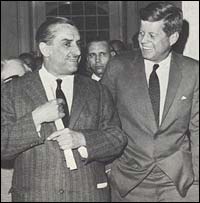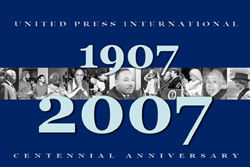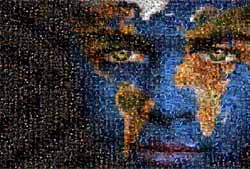1907 - 1910
1911 - 1920
1921 - 1930
1931 - 1940
1941 - 1950
1951 - 1960
1961 - 1970
1971 - 1980
1981 - 1990
1991 - 2000
2001 - Today
|
 |
1963
 |
|
UPI Legend Merriman Smith with President Kennedy in 1962 (Courtesy of Bob Lowry)
|
UPI's White House Correspondent Merriman Smith was in the motorcade, in a press car four cars behind the president's open limousine, as John F. Kennedy drove through Dallas on Nov. 22. As the motorcade passed the Texas School Book Depository, Smith heard three loud bangs that he recognized as gunfire. Sitting in the middle of the front seat, Smith grabbed the car's radio-telephone and called the Dallas bureau. Wilborn Hampton answered and handed the phone to Southwest Division Editor Jack Fallon, who dictated a bulletin to staff editor Don Smith. Teletype operator Jim Tolbert filed the bulletin that gave the world the first word that shots had been fired at Kennedy's motorcade. Hampton meanwhile phoned a police dispatcher who confirmed the three shots and said there was a rumor the president had been hit. The press car followed the limousine as it raced to Parkland Hospital. As Smith ran up to the limousine parked at the emergency entrance, he saw Kennedy face down on the back seat, with Jacqueline Kennedy cradling her arms around the president's head. Smith saw a secret service agent he knew and asked him about Kennedy. The agent, Clint Hill, responded: "He's dead." Smith went inside, found a phone and reached Fallon, who dictated the flash: "Kennedy seriously wounded, perhaps seriously, perhaps fatally by assassins bullet." When White House deputy press secretary Malcolm Kilduff gave official word at the hospital that Kennedy was dead, Hampton, Joe Carter and Preston McGraw set up a three-man relay between a pay phone and the news conference -- one at the conference, one running between and a third dictating to the bureau. That was backed up by Virginia Payette on a second phone and Smith, who had found a third line. Smith then went back to Air Force One, and witnessed the swearing-in of Lyndon Johnson as president. Smith's account of the assassination won the 1964 Pulitzer Prize for national reporting.
1963
The picture of John F. Kennedy Jr. saluting the casket of his father is one of the most poignant images from the weekend that shook the nation and the world. UPI photographer Stan Stearns took the picture outside St. Matthew's Cathedral, after the Kennedy family emerged from the church following the funeral for President John F. Kennedy on Monday, Nov. 25. Kennedy had been assassinated in Dallas three days earlier. Stearns' photo shows the boy in coat and short pants, right hand at his forehead in salute. Stearns, stationed outside the church with about 75 other photographers, had focused a 200mm lens on Mrs. Kennedy, who stood next to John Jr. "All of a sudden she bent down and whispered in his ear," Stearns said. "His hand went up and 'click,' that was the picture." It was the only picture Stearns took outside the church.
1968
UPI radio correspondent Roger Norum was in Saigon May 6 tape-recording the sounds of combat as a group of South Vietnamese and South Korean soldiers attacked Viet Cong guerillas on the outskirts of Saigon near the airport. He encountered UPI photographer Charles Eggleston, in Rocket Alley near Plantation Road, in the middle of a burning village area. A Vietnamese woman warned them of Viet Cong nearby, as automatic rifle fire and rocket-propelled grenade explosions erupted around them. Norum kept his tape rolling. Eggleston asked for a match to light a cigarette, and a bullet whizzed close to Norum. There was the sharp crack of another round - and Eggleston fell dead, shot in the head. The tape was broadcast later that day. Eggleston, who had won two bronze stars while a Navy journalist before working for UPI, left his estate to Vietnamese orphans.
|


